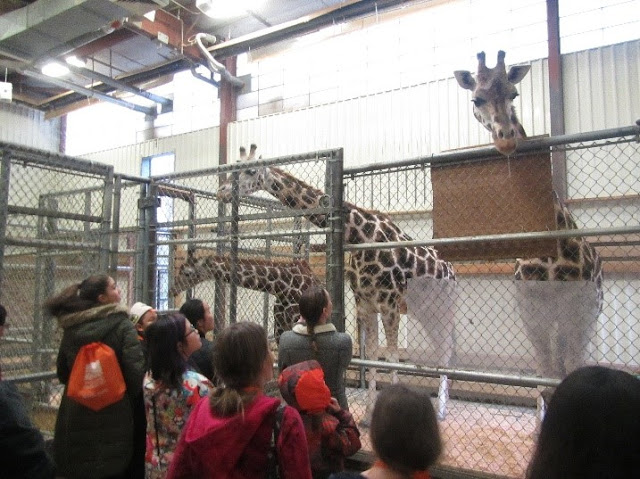Posted by: Ryan Driscoll, Education
Photos by Ryan Driscoll, Woodland Park Zoo
The issues of poaching and wildlife trafficking can seem black
and white—it’s bad news. At least that
was the initial sentiment of many of the middle school students who
participated in this last semester’s ZooCrew, Woodland Park Zoo’s after-school program. However,
as the students explored the issue, they started to realize just how complex
the causes and solutions can be.
One
student explained why poaching in Africa can be a difficult issue, “people
poach because they need the money and they can’t find a job that will pay them
enough. They need to have a way to feed
their families.” This led the students
to explore a range of solutions such as recruiting those poachers to become
rangers (who protect wildlife), building sustainable industries and supporting
local communities that offer alternative employment. They then explored ways that people here in
Seattle could help. They created projects based on these ideas which were presented
to others on their zoo field trips throughout January. Here are just some of the highlights,
activities and projects from this last semester:
 |
| ZooCrew students greet an Egyptian tortoise. |
 |
| ZooCrew students spend time together making conservation props. |
Bowling for Rhinos
One of the most iconic victims of poaching is rhinos. For the second year, ZooCrew partnered with
the Puget Sound Area Association of Zoo Keepers (PSAAZK) to prepare projects
that will be presented at Bowling for Rhinos, an annual fundraiser for the LewaWildlife Conservancy in Kenya. Some
groups chose to make videos to inform guests at the event about the threats
rhinos face and ways they can help protect them. Other groups aimed to share similar
information in the form of trading cards.
Students and their projects will attend the Bowling for Rhinos event on
May 5th to educate participants as well as enjoy a night of bowling, taco bars,
and raising money and awareness for rhino conservation.
Conservation Innovation
Four groups used their creativity to find new solutions for wildlife
trafficking and poaching. One group
explored ways to keep predators and livestock separated to reduce retaliatory killing
in ranching areas by creating living bamboo fences. Another group looked at the illegal pet trade
and how it impacts animals like servals—advocating for domestic cat species
that have similar appearances but aren’t wild animals. Two more groups discovered alternatives to
poached products—focusing on the use of tagua nuts as a replacement for ivory soap
carvings. Another looked at a variety of
alternative products including synthetic furs, skulls and possible replacements
for traditional medicines made from endangered species.
 |
| ZooCrew students present their ideas to zoo staff and volunteers. |
 |
| Those sheep are safe thanks to bamboo barriers, great idea! |
Citizen Science with Camera Traps
Camera traps are necessary tools for conservationists to
study animals in the field, but they can often lead to large caches of photos
that need to be sorted. In some cases, researchers have turned to the public for help.
Two groups assisted with a back-log of images by sorting through
hundreds of photos from various projects in Africa and coding them based on the
animals they contained. Not only did
they learn how to tell a wildebeest from a gazelle, but they helped create a database
that scientists will use to determine the population size and distribution of various
species on the savanna. The ZooCrew students encourage you to head to www.zooniverse.org and find a project to
help with!
Conservation Advocacy
Two groups aimed their projects at a broader audience with
the intent of informing people about why poaching is a problem and what they
can do to help. One group focused on
poaching here in Washington state and highlighted actions like reporting
suspected poaching to the Washington Department of Fish and Wildlife. The other group focused on the Amur leopard
and researched organizations that help not only the leopards but local communities.
Restoration Field Trips
ZooCrew doesn’t just happen in schools and the zoo. Each semester, we aim to get out into the
community to help improve the green spaces around the students’ homes. In October, we participated in Green SeattleDay and helped to plant trees in Jefferson Park—right next to one of our school
sites! Together with other community
members, we helped plant over 100 native trees and shrubs at our work
location. In November, we braved the
rain to help remove invasive ivy from Lincoln Park in conjuncture with Friends
of Lincoln Park. A special thank you to
the family members that came out to help make our green spaces a better place
for animals and people!
Zoo Field Trip
At the end of each semester, students and their families
from all three sites come together at the zoo.
They started the day being toured around by some amazing teens from the
ZooCorps program. This was followed by
our customary pizza lunch and a wonderful presentation by Sarah Werner, the
zoo’s Senior Interpretive Content Developer.
Sarah discussed the design process her team goes through when working on
the signs and interpretive elements around the zoo. She also gave us a sneak
peak of the new Assam Rhino Reserve exhibit space coming this spring! Groups then headed off to special keeper
talks at the Tropical Rain Forest dome and the giraffe barn. Finally, they presented their projects to a group of staff
and volunteers.
 |
| Giraffes check out the ZooCrew team. |
As the fall program wraps up, we wanted to extend a giant THANK
YOU to our community partners, ZooCorps volunteers, and the zoo staff who help
make this program possible. We also
wanted to thank the parents and guardians who make so many of these
opportunities possible for their students.
We look forward to our spring semester where we will delve into climate
change action and the ecosystems of the tundra, taiga, and temperate forest!
 |
| Great work ZooCrew! |







Comments
Post a Comment